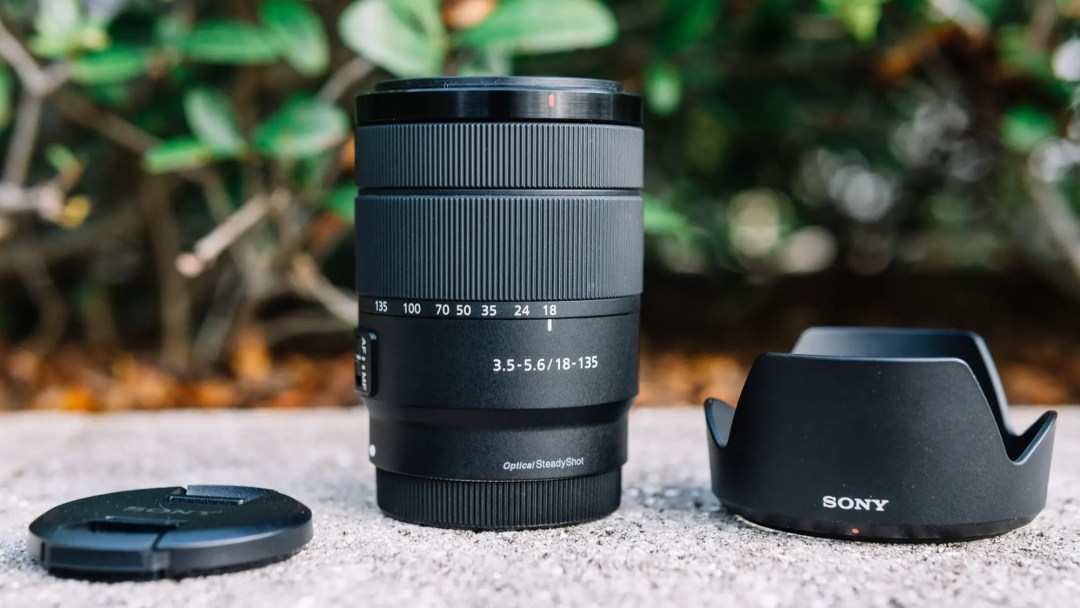The beauty of owning an interchangeable lens camera like the Sony A6000 is that it provides options. However, options can be as much a curse as they are a gift. Too many options can cause something called decision fatigue, which is basically the idea that continuous decision making can cause unnecessary mental stress. As an enthusiast photographer, this is something I experience any time I pack my camera gear for a trip. I spend so much time and effort deliberating what to bring, yet I almost always pack everything I own—you know, just in case. But regardless of how many lenses I end up lugging around, I find that the majority of my photos are usually taken with one specific lens that stays glued to my A6000: the Sony E 18-135mm f/3.5-5.6 OSS zoom lens.
Introduced in 2018, the Sony E 18-135mm f/3.5-5.6 OSS lens is a relatively new APS-C zoom lens that covers a highly versatile focal range equal to 27-202.5mm on full-frame. The focal range of this lens puts it in the “all-in-one” or “super-zoom” lens category, which makes it useful for all types of photography genres and compositions, from wide-angle landscapes to isolated portraits. Zoom lenses like this tend to get a bad rap for making quality concessions in the interest of convenience, and yes, Sony did have to make some compromises to make this lens what it is.
But then again, convenience is exactly why this lens stays attached to my camera. Why complicate my photography experience by cycling through multiple lenses when I can have one lens that covers it all? Everything about the 18-135mm seems like it was built to be that go-to travel lens. It’s versatile, compact, and budget-friendly compared to other E-mount zooms on the market.
Those invested in the E-mount system know that there’s been some neglect regarding Sony’s APS-C lenses. And the available lenses on the market aren’t exactly easy on the wallet. Most zoom options are either full-frame oriented and/or have pro spec’d glass that will easily run the cost up to and over $1,000. However, the 18-135mm retails for about $550 new, which is already significantly cheaper than other zooms in the E-mount system. But because you can get this lens bundled with the A6400, A6500, or A6600, you can easily find it being re-sold used on eBay for significantly less than its retail price. At this price-point, the lens is geared towards consumers in search of convenience, so I wouldn’t recommend the lens for professional gigs. However, it’s definitely a worthy option for budget-oriented enthusiasts or beginners looking to travel minimally, while still retaining the image quality of multiple prime lenses.

Build and Handling
Design-wise, the 18-135mm isn’t anything special. It’s basically just a matte-black cylinder that tapers down slightly towards the mount end of the lens with an unassuming front glass element and a 55mm diameter filter thread. It’s got a generic look to it that keeps it in line with most kit lenses I’ve seen on other cameras. Looks aside, the real draw of this lens is its size and weight. In fact, this lens is even smaller and lighter than a can of your favorite brew.
Weighing in at 11.5 oz (325 g) with a diameter of 2.75 inches (67mm) and length of 3.5 inches (88mm) unextended, the lens is impressively tiny compared to other super-zooms. For comparison, its closest competitor, the Sony 18-105mm f/4 G lens, is about an inch longer and 5 oz heavier.
To make the lens so compact and light, Sony made two trade-offs: they used lightweight plastics to make the barrel (don’t worry, the lens mount is made of metal), and they gave it a variable aperture. Despite being made of plastic, the lens feels pretty solid, and when mounted on one of Sony’s APS-C cameras, the whole package feels well balanced (though its matte black paint job doesn’t exactly match with the glossy finish of the A6000). Regardless, combined with the camera body, the combination is compact enough to fit in a small side bag or purse, and light enough to keep slung around your neck all day. Its ultralight form-factor alone makes this lens my go-to for outdoor and city adventures that require significant travel on foot (though I have to be conscious of weather conditions as this lens does not sport any type of protection from the elements).
On the center of the barrel is the zoom ring, which takes up a large portion of the real estate, and in front of that sits the electronic focus ring. Both rings are smooth in operation and textured with a ribbed rubber that’s easy to grip. The zoom throw is fairly short—about 90 degrees of a full turn—so it only takes a couple seconds to zoom from 18mm to 135mm and back. Extending the lens fully to 135mm adds about an inch to the barrel’s original form-factor, but it still feels balanced on my A6000. The zoom itself is nicely dampened, and helped in part by its lightweight nature there’s no zoom creep to worry about when shooting at an upward angle.
Additionally there’s an AF/MF switch on the left side of the barrel. This feature is convenient for when you want to switch between auto and manual focus on a whim. I don’t use it much, since I use Direct Manual Focus most of the time, but it’s a nice little bonus to have in a pinch.

Image Quality
The most obvious caveat about the Sony E 18-135mm f/3.5-5.6 OSS is that it’s a variable aperture lens. The lowest aperture value shifts between f/3.5 and f/5.6 based on the focal length. At its widest, the fastest aperture is f/3.5, but halfway through the zoom range (55mm) the aperture shrinks to f/5.6, which remains constant through its longest focal length. This might be off-putting to many (it was for me personally), especially since there are competitor lenses with constant apertures on the market, but after using the lens for some time, I’ve learned to work around this limitation to create some images that I’m really proud of.
| Focal Length | Max Aperture |
| 18mm | f/3.5 |
| 24mm | f/4 |
| 35mm | f/4.5 |
| 50mm | f/5 |
| 55-135mm | f/5.6 |
The lens utilizes seven aperture blades to create a circular aperture, but because it’s a slow lens, don’t expect dreamy out-of-focus areas in your shots. While bokeh from this lens is a bit harsh, you can achieve some decent separation by zooming in and getting as close to your subject as possible. Luckily, the lens has a surprising ability to focus as close as 1.5 feet at all apertures, which helps to make up for its relatively harsh depth of field rendering. With that said, I find that this lens performs best outdoors during the day (when its variable aperture doesn’t make too much of a difference) and shines most when used at lower apertures (f/5.6-f/11) to provide a deep depth of field for travel and landscape type photographs.



Despite being primarily a day-time use lens, the 18-135mm can produce some decent results in low light thanks to the stabilization technology (Optical Steady Shot (OSS)) integrated in this lens. As someone who absolutely hates carrying around a tripod, OSS (in combination with higher ISO settings) allows me to handhold the camera at lower shutter speeds than I initially expected. OSS makes capturing handheld shots very easy, canceling out any possible camera shake you might experience once you enter the telephoto range of this lens. Personally, I’ve taken handheld shots as slow as 1/50th of a second zoomed to about 80mm with no visible camera shake. Unfortunately, the lens does not include a dedicated switch to disable OSS, but you can easily dive into the menu to disable it when necessary.
In combination with its compact footprint, the sharpness of this lens is another reason that I can so honestly recommend it. For a lens of this class, a kit lens which can “do it all” at a minimal cost, it’s remarkably sharp from 18 to 135mm across the frame, even shot wide open. For pixel-peepers, I’ll concede that there can be some softness in the extreme corners when you’re shooting wide open at 18mm, but either stopping down or zooming in a bit easily clears this up. Regardless, this lens is consistently sharp in the center (where it really counts, ‘cause who’s really scrutinizing the extreme corners?). Despite a minimum aperture of f/22, I typically avoid stopping the lens down to apertures lower than f/11 to ensure the sharpest photos possible and to prevent diffraction, which can lead to some softness in the frame.
If it means anything to you, the glass is constructed of 16 elements in 12 groups with one aspherical and two extra-low dispersion elements. With that said, the glass used in the 18-135mm can be considered inferior to more pricey zoom options, so there are some optical imperfections to be expected. Most notably, the lens displays significant vignetting and distortion, which is strongest when shot at the widest and longest focal lengths (18 and 135mm). However, closing the aperture down a couple stops from the max and/or zooming to one of the mid-range focal lengths almost entirely helps to mitigate the distortion (though there’s still a bit of vignetting). You’d honestly probably never notice these imperfections because the in-camera software does a fantastic job of eliminating optical issues for immediate viewing, which is particularly good for JPG shooters.
The only way to see the extent of the distortion is by importing the RAW files into Lightroom. At 18mm, you’ll notice that the lens doesn’t fully cover the APS-C sensor it was made to work with. But luckily, Adobe has a dedicated lens profile to easily make the necessary corrections in post. I can see how heavy reliance on software corrections might be off-putting to some purists out there, but personally, I’m okay with adding an extra step to my workflow in order to keep a couple hundred dollars in the bank.


Despite heavy optical distortion, everything else is well controlled on this lens, including chromatic aberration, flaring, and ghosting. Occasionally, I can see some minimal fringing in high-contrast areas of my photos (like where foliage meets a bright sky), but it’s significantly less than the faster E-mount lenses I own. Depending on the conditions, there can be some minimal flaring/ghosting, but you’d have to point it almost directly at the sun. I haven’t noticed anything significant in more normal situations, but I typically keep the included tulip-shaped hood attached to the lens at all times.
The internal autofocus motor in this lens is quick, accurate, and completely silent in basically all kinds of lighting, even indoors. And because the 18-135mm is a native Sony lens, it plays nice with their excellent autofocus system, so you can rest assured that you’re utilizing its full auto-focus potential despite losing light with the lens’ varying aperture.



Quick Notes on the Competition
As mentioned earlier, there aren’t too many all-in-one zoom options for the Sony APS-C system, but there are some other lenses I considered before ultimately deciding on the 18-135mm. Its closest competitor is the Sony 18-105mm f/4 G lens, which costs $50 more and sports a constant f/4 aperture. I was between these two lenses initially, but ultimately chose the 18-135mm based on its size and weight comparisons. The 18-105mm is considerably larger and heavier, and as a stills shooter, its electronic zoom was less than ideal for me personally. If you’re between these two lenses, I say go with the 18-105mm if you’re a videographer or if size and weight are not deal breakers for you. Otherwise, the 18-135mm is equally as sharp and a more ideal choice for travel.
There’s also the Sony 18-200mm OSS f/3.5-6.3, which has a slightly longer zoom, but it’s outdated, more expensive ($750), heavier, and (by all accounts) is not as consistently sharp compared to the 18-135mm. Another close competitor is the Sony Zeiss 16-70mm f/4, which is about the same size, but doesn’t offer as much reach and pushes the budget to almost $900 new. Additionally, many users of this lens suggest that its optical quality is not quite on par with what is expected of the Zeiss moniker.
Even including these honorable mentions, no other E-mount lens on the market offers the same combination of flexibility, cost, and quality as the Sony E 18-135mm f/3.5-5.6 OSS.

Jack of all Trades, Master of None
If there was ever a photography-related embodiment of the “jack of all trades, master of none” figure of speech, it might be Sony’s 18-135mm lens. The versatility of this glass allows it to fill many shoes, but at the end of the day, it’s not perfect. The not-so-premium build quality, lack of weather sealing, slow, variable aperture, and heavy reliance on software corrections will certainly deter buyers in search of pure optical perfection. However, those willing to make some compromises for the sake of convenience might actually consider this lens the perfect companion.
While this lens won’t exactly put an end to your case of GAS, the Sony E 18-135mm f/3.5-5.6 OSS is an excellent solution for photographers looking to simplify their decision making process, and ultimately their photography experience. This includes avid travelers and outdoor enthusiasts on a budget who value minimalism and versatility over optical perfection. From personal experience, the combination of size, zoom range, stabilization, and image quality this lens provides outweigh the caveats in real world use. I am consistently impressed with the results produced by what could technically be considered a kit lens.
Despite the compromises Sony made with this lens, I think the only thing I would change is the price. Personally, I think the lens is just slightly overpriced, and it would better serve its user base if it was listed closer to $450-500. But at $550 for a new copy, I think you get the most value when you buy this lens second-hand or bundled with one of Sony’s newer APS-C cameras. If you already own an A6-series body, and you’re considering the 18-135mm lens, I highly encourage searching eBay and other outlets where you’ll find this lens being resold in abundance for between $300 and $400. Probably the only instance in which its reputation as a kit lens works in its favor.
I’m fully aware of the zoom versus prime lens debate, and while prime lenses produce cleaner results, they just don’t offer the sheer flexibility of an all-in-one zoom lens. Don’t get me wrong, keeping a couple extra primes in my travel kit to complement my Sony E 18-135mm f/3.5-5.6 OSS has turned out to be a good thing, but I feel like sometimes the physical and mental burden of multiple lenses isn’t worth it.
Call me lazy, but that’s what I like about the 18-135mm lens; it just simplifies things for me. I’ve found that limiting my lens options and traveling light helps me mitigate my decision fatigue and enjoy my experiences more. I sincerely think that the real-world performance of this lens far exceeds the expectations of what can be considered a budget-friendly, all-in-one zoom kit lens. And in my humble opinion, this lens deserves more recognition in the E-mount ecosystem as a worthy contender for the best ultralight lens option for Sony APS-C shooters.
Get the Sony E 18-135mm f/3.5-5.6 OSS Lens new from B&H Photo here
Find one used on eBay here
Follow Casual Photophile on Facebook and Instagram
[Some of the links in this article will direct users to our affiliates at B&H Photo, Amazon, and eBay. By purchasing anything using these links, Casual Photophile may receive a small commission at no additional charge to you. This helps Casual Photophile produce the content we produce. Many thanks for your support.]



















One more anecdotal use case for this lens: I work in a local public radio newsroom. As our journalists are out covering stories, they are primarily interested in collecting audio for the airwaves. But the digital newsroom being what it is, everything goes up on the web and everything needs some kind of visual. For journalists already hauling around a bag of audio recording equipment, a camera with multiple lenses is less than ideal. Our aging Canon Rebels with 18-55mm kit lenses had proven too limited for many media coverage scenarios (along with just reaching their end of life). When it came time to upgrade the camera kits, I decided that the a6300 and this 18-135mm lens would provide the journalists with a lot of capability without adding much weight or bulk to their bags. They could grab wide photos of a crowd of demonstrators as well as get tight photos of our leaders from across the room in a fixed media pit. Pragmatism and flexibility over creative control. There is absolutely a need for these kinds of lenses, as unappealing as they might seem to those of us who crave total control over every aspect of the image (and consequently end up carrying ALL of our specialized lenses everywhere we go, ha!). The 18-135mm has proven to be versatile, robust, and an all-around good performer for us. Cheers!